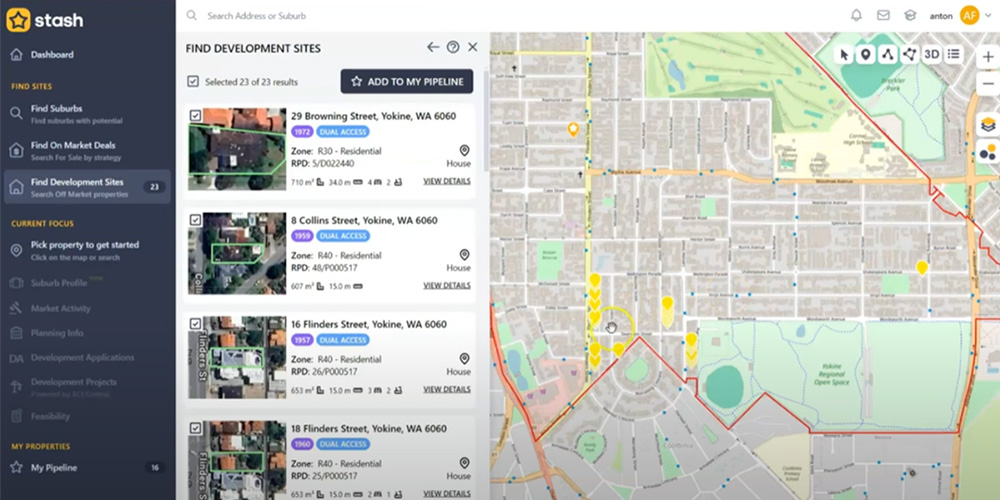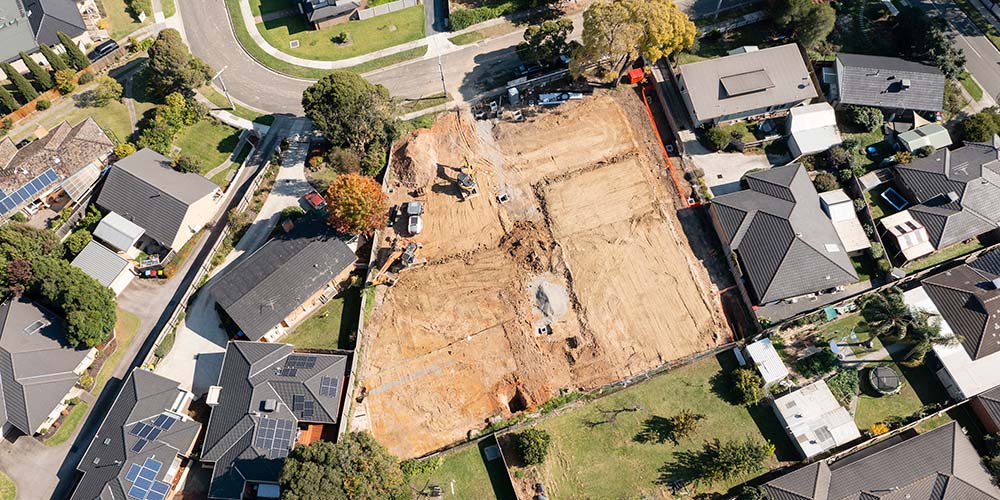
An Overview of The R Codes WA – How do They Effect You?
Do you know what the R-codes are? Did you know they have been recently updated? For the purposes of small lot subdivision and infill development in western Australia, the most important reference document is State Planning Policy 7.3 vol 1 the R-codes. WA state government Acts reference the document, as a consequence its gazette means it is a legal requirement to comply with the R-codes when developing and subdividing property in Western Australia. This article will provide an overview of the R-codes of Western Australia, how they need to read and how local governments are empowered to modify provisions in these codes. Its very important for you to understand the the codes and how to apply them- if you understand them you will be able to assess a sites development potential, know how many lots you an create, what you can and cant build on the lots. Understanding the R-codes really is your stepping stone to assessing project feasibility and making sound investment and project commitment decisions.
In essence , the residential design codes (or R codes WA for short) provide the minimum performance requirements (compliance standards) for single, grouped and special purpose dwelling planning assessment in low to medium density coding in Western Australia. The document is available for free online at the DPLH website, along with accompanying explanatory notes and guidelines.
It is important to understand that local governments (councils) are empowered to (and do) supplement the requirements of the R-codes in their Local Planning Scheme Text and referenced Local Planning Policies (LPS and LPP). They are empowered to do so under section 7 of the R-codes, discussed later in this article.
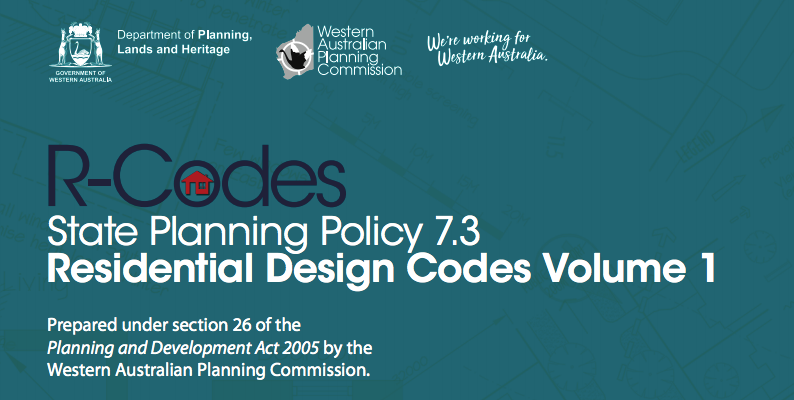
How to interpret the R Codes WA
First, you need to understand how to read the document.
The R-codes define planning performance requirements, and provide Deemed to Comply (DTC) solutions to meet these requirements. Alternative Design Solutions (ADS) to meet performance requirements are possible with expert justification and the agreement of the decision maker (WAPC or Local government, whoever is sent the development or subdivision application).
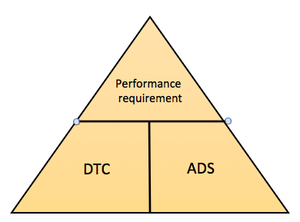
Planning Triangle to illustrate that a performance requirement can be met with either:
- a deemed to comply provision (either one referenced in the R-codes or one provided by a local government planning policy) or
- an alternative design solution (expert opinion and design with justification that broader policy objectives of the performance requirement are being met by alternate means to the deemed to comply solution/s provided in the R-codes or the Local planning policy.
The Performance Requirements and Deemed to comply provisions will use specific terms of reference. These important terms will be highlighted in bold writing in the residential design codes document.
It is important for you to understand that every term in the R-codes has a specific definition. If you are uncertain what a term means, obtain the definition from the appendix to assist you with interpreting provisions in the document correctly.
To avoid costly errors and planning delays, you must first be able to identify which planning performance requirements are applicable to your development. Second, if viable, economical Deemed to comply or Alternate design solutions are available to you to meet these performance requirements.
Section 5 of the Residential Design Codes
SPP 7.3 Vol 1 “the R-codes” outlines important performance requirement in the following sections to guide design compliance of your subdivision and dwelling designs:
- 5.1 Context
- 5.2 Streetscape
- 5.3 Site Planning and Design
- 5.4 Building Design
- 5.5 Special Purpose dwellings
There is also an Appendix for definitions, Tables for summary of site requirements ( Table 1 being the most important ), and a series of illustrated Figures to compliment deemed to comply design provisions referenced in parts of Section 5.
Table 1 of the Residential Design Codes
Table 1 is very important because it contains the minimum and average site area requirements, setbacks and minimum percentage of open space that you must comply with for a legally compliant development.
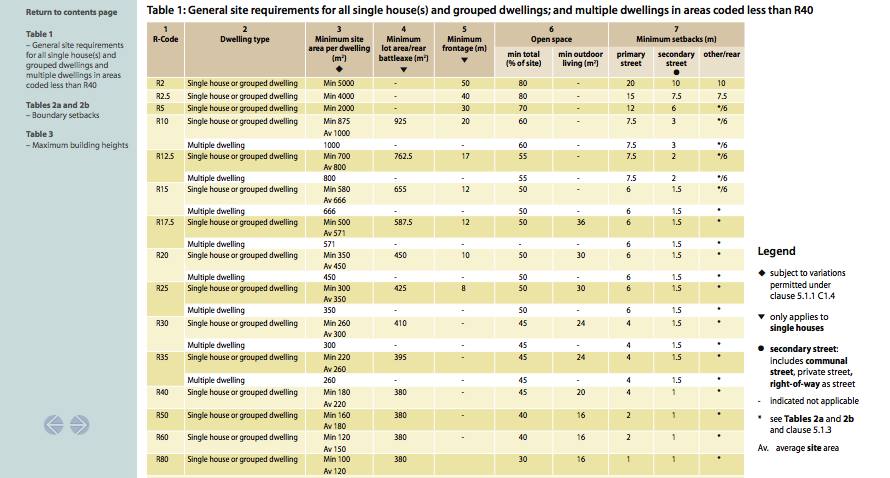
excerpt of the R codes WA table 1
For example, if your block is zoned R20, it must have a minimum site area of 350m2 and an average site area of 450m2. So, to subdivide an R20 block in half it must be 900m2 minimum, to make 2 blocks of 450m2 each. The minimum allowable percentage of open space is 50%, so you can build a single story house on each no larger than 225m2 floor area.
You can learn more about applying the R-codes and interpreting subdivision potential on the can I subdivide land page of our website.
Section 7 of the Residential Design Codes
Section 7 is an important part of the R-codes. In a statutory context, it is where authority is delegated to Local Governments (councils) to:
- Amend or replace Deemed to Comply provisions for some performance requirements in the 5 design elements in section 5, as listed section 7.3.1
- Amend any other deemed to comply provisions, if granted approval by the WAPC to do so, by way of a local planning policy or local development plan provided it is consistent with the objectives and design principles in the R-codes.
Would you like to learn more about how the R-codes impact your subdivision or development in WA?
If you dont understand how the R-codes and planning regulations apply to your subdivisions and developments, you run the risk of making costly investment mistakes and decisions. This occurs because you think the site you already own has profitable development potential, or worse, you buy a site you think can be developed in a certain way and it cant. To avoid these mistakes, you need to educate yourself on state planning rules, local government planning rules, and how the two interact. There are four whole chapters and learning modules covering these topics, including planning concessions and variations, in our 225 page Infill Property Developer Guide-book and correlating Online Course. Give yourself the edge like the rest of our customers- get started now!
